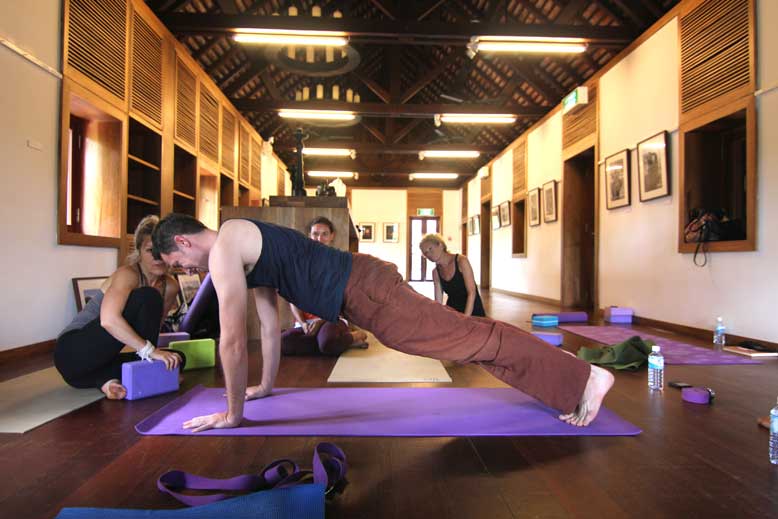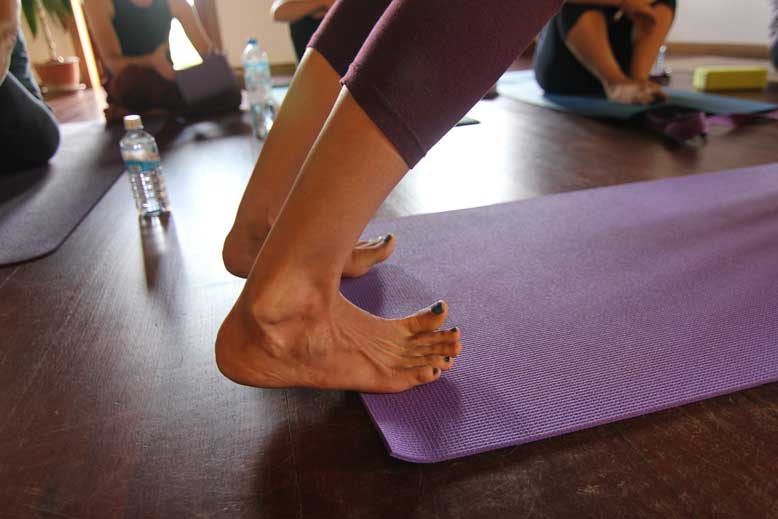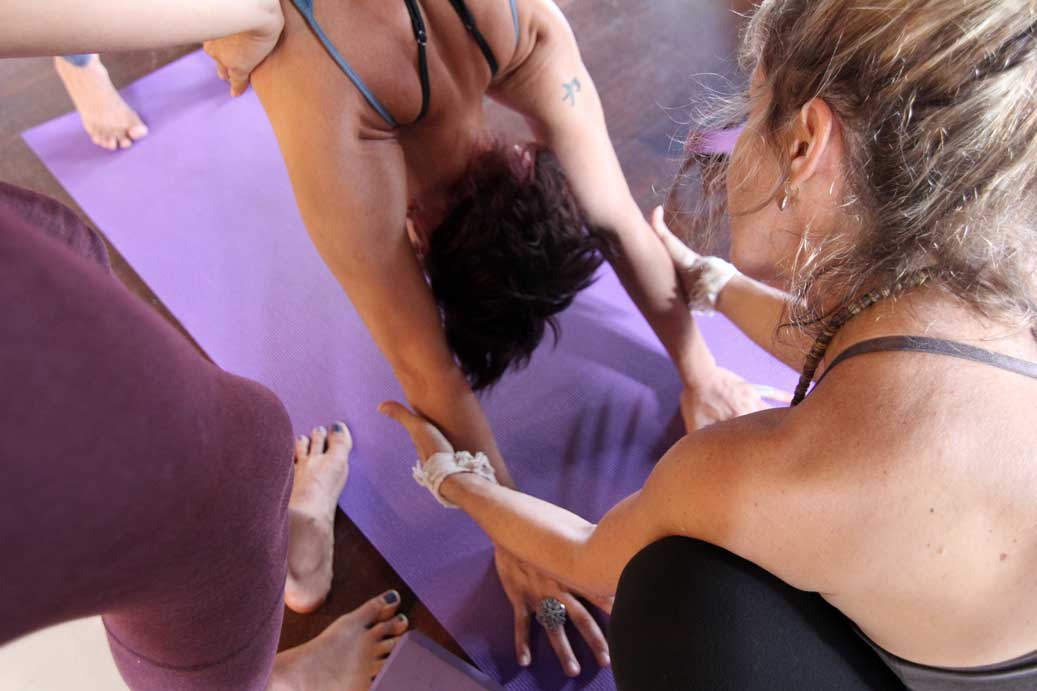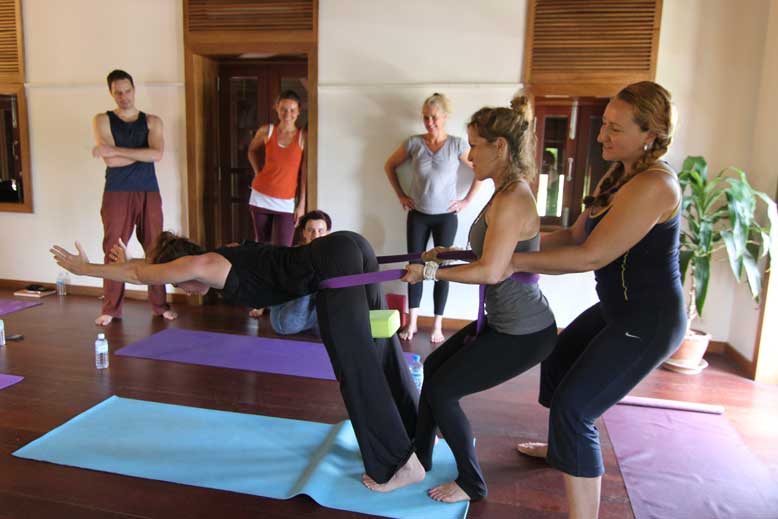|
Downward-Facing Dog or Adho Mukha Svanasana is a posture that’s practiced often in most forms of yoga. In fact, it’s likely that your yoga practice will consist of at least one downward facing dog no matter what style of yoga appeals to you. While this posture is often referred to as a resting posture in Vinyasa Flow yoga, taken as a break between standing postures, it’s an incredibly demanding position that requires your entire body to be engaged, your breath to be active, and your awareness to be fully present. Jessica Magnin’s recent workshop at the Hotel de la Paix in Luang Prabang broke down this complex asana, transforming it part by part. There were a few “aha!” moments in the workshop as participants expressed freedom in the experience of being aligned. We’re sharing these useful tips with you. To begin, downward facing dog is a posture of reflection and a posture of humility. The head hangs below the heart as we reflect upon the experience of our practice. In Vinyasa Flow yoga, we come into adho mukha svanasana in between standing postures on the left and right sides. In downward facing dog, we restore equilibrium, we restore our awareness, and we bring ourselves back to the present as we observe and fully engage all parts of the body once again.
Blog post by Julie (juliehana.com)
0 Comments
 Here in Luang Prabang, we’re blessed with the kind of weather that allows us to practice yoga outside almost all year round. But practicing outdoors is not always easy. Most people are used to practicing indoors, in a quiet room, enclosed by walls that physically create the feeling of personal space. Outside, the weather, noise and insect life can often be distracting, but the joys of an outdoor practice far outweigh the cons. Here are ten reasons to practice outside while you’re in Luang Prabang and elsewhere, as well as some tips on how to make the most out of your outdoor yoga practice. 1. Where else can you practice with a picture perfect view of the Nam Khan and Mekong rivers? Most yoga studios are indoors, so most likely, a majority of your yoga classes have taken place inside. This makes sense considering most people live in cities that are not conducive to an outdoor practice either because the weather is not favorable or the environment, such as traffic and pollution, do not support a healthy practice. In Luang Prabang on the other hand, mountains, rivers, great weather and a slightly less modernized environment surround us. Yoga decks on the Nam Khan and Mekong rivers therefore can be used year round. Where else can you get this kind of view? 2. The ancient yogis drew their inspiration from nature. Practicing outdoors can help you connect more deeply to your yoga postures. Ancient yogis observed the natural environment in which they existed and understood how living things drew the energy of Mother Nature to survive and thrive. In modern day yoga asana practice, postures are often named after the natural elements that they represent. While practicing outdoors, draw inspiration in mountain pose from the mountains in the distance or root into the earth like the tree in front of you. Perhaps even experience gratitude for life as you salute the sun while it rises from the horizon. 3. Yoga is about non-duality. Feel oneness with the universe as you practice outside. In non-duality we remove the separation between the universe in which we exist and ourselves as individuals. This is a difficult concept to experience as modern society puts a high value on individuality, placing importance on the “Me,” “I” and “My.” Within the walls of a yoga studio, the focus is often on “my practice,” “my progress,” and “my space.” While there’s nothing fundamentally wrong with this, the experience of an outdoor practice can be eye opening. Outside we have less control over our environment and as such, the practice no longer becomes about “me.” It’s easier to realize our tiny significance and insignificance in the larger scheme of the universe as rivers flow, birds fly and insects buzz around, each with their own role to play, without concern or care that we’re out there in the middle of our yoga practice. 4. Have you ever seen the full moon rising behind the mountains and light up the river in front of you as you awake under a starry sky from Savasana? During the winter months in Luang Prabang, the full moon rises above the Nam Khan River, usually at the end of the sunset yoga class, as yogis make their way towards or out of Savasana. The yoga deck is lit with candles. There’s not much else to say about this one. 5. Peace comes from within. There’s a misconception that an enclosed room will protect you from noise. Perhaps if the building were soundproof this would be true. The reality is however, that most are not. Even within the confines of walls, you can hear the rumbling of motorcycles outside, the sound of construction equipment from the house next door or the clatter from the neighbor’s kitchen. Walls often create the illusion of quiet, but true peace comes from within. Practicing outdoors encourages us to quickly look inside ourselves as we cannot always rely on our environment to create the feeling of calm. 6. We naturally feel happier outside, in the sun. It’s common knowledge that catching some sun each day helps to boost serotonin levels and makes us happier people. Maybe it’s a combination of the view, the sun and the yoga, but yogis coming off a practice on our outdoor deck definitely look like they’ve had a dose of the happy pill. If that isn’t a reason to practice outside, I don’t know what is. 7. Problems with mosquitos? There’s nothing a little mosquito spray can’t fix. Mosquitos and other insects appear to be the number one reason why people don’t want to practice outside. During the rainy season here in Laos, mosquitos can be more of a nuisance than in the dry, winter months, but that’s not something a little mosquito spray can’t fix. If you’re considering practicing outdoors regularly and are concerned about too much use of Deet, natural insect repellents are just as effective. They need to be reapplied every 3 hours instead of the usual 7 hours required for sprays that contain Deet, but that’s enough for a 90-minute yoga session. 8. Learning to deal with unexpected situations is a step towards living life happily. It’s true that it’s a lot harder to control the environment when practicing outdoors. From unpredictable weather, to people chatting, to interruptions from insects and animals, there are a lot of factors beyond our control. But isn’t it also true too that unpredictability is a fact of life? Learning how to navigate unforeseen situations without letting them affect us is key to living a happy life. Next time something happens that’s not within your control, observe how you react to it. Through an outdoor practice, you can hone the ability to let the little things slide with indifference. Does it really matter if someone accidentally walks into your personal space? Was it really “your” space to being with? 9. Experience freedom by practicing outdoors. Ah freedom! It’s something we strive for, yet most of us don’t really know what it feels like. Practicing yoga outdoors can help us experience freedom in a way that cannot be easily replicated indoors. The expanse of the sky above can give us a sense of freedom as it takes us away from the enclosed environments that we are usually confined within (house, office, car etc.). Outside, space is limitless. We connect to this limitless space as we extend upwards from our heels to the crown of our heads and from fingertip to fingertip as we spread our arms like wings into the vastness of the outdoors. 10. If you can practice outside, you can practice anywhere, anytime. If you build the ability to practice outdoors, you can pretty much guarantee that you can take your yoga practice anywhere. All you have to do is find a flat surface, close your eyes, look within, and the perfect yoga space can be created. Blog post by Julie (juliehana.com)  There are good yoga teachers, and then there are great yoga teachers. The good teachers challenge us. Physically, they help us push the limits of our capabilities. Mentally and emotionally, they impart confidence, self-worth and discipline. The great teachers however, touch our souls in a way that causes a vital shift to our inner being, leaving us a little bit transformed. In this lifetime, we will likely only encounter a handful of these great teachers. We may not recognize them upon first meeting them. Most probably, we would not have heard of them before. Teachers like these do not seek fame. Rather, they practice and teach, touching one person at a time, without the need for recognition and without the need to be commended. In the end, it is not their goal either to instill these changes in others. Those who come with an open heart and mind will gain the benefit of their teachings. Those that are closed to it will not. They don’t tell us what we should or should not do or think. They do not judge us for how we live our lives. Most importantly, great teachers grow in us, the desire to be better people, to be selfless people. In a single class, these teachers can make you feel your smallness in the larger scheme of the universe, yet feel so connected to it at the same time; to want to sacrifice your own goals for those of humanity; to feel deeply for all of humanity; to have compassion for all things good and bad; to love and to truly seek peace. To all the inspirational teachers out there, THANK YOU! Blog post by Julie (juliehana.com) |
Archives
September 2023
Categories
All
|





















 RSS Feed
RSS Feed
